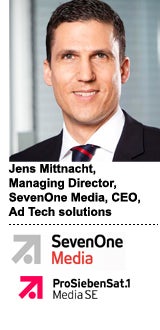 ProSieben, one of Germany’s biggest broadcasters, is expanding its programmatic TV footprint in a market that’s both vibrant and uniquely challenging.
ProSieben, one of Germany’s biggest broadcasters, is expanding its programmatic TV footprint in a market that’s both vibrant and uniquely challenging.
Because Germany is so decentralized – it is characterized by numerous regions but lacks a local TV presence – broadcasters wield more control over their end inventory.
As a result, they’re typically able to monetize directly through media company-owned sales houses, generate a higher yield on that inventory and bypass some of the channel conflict that can arise in the US spot market.
Germany could significantly expand its TV advertising footprint, particularly for verticals like beverage or beer brands that have different regional product penetration, according to Jens Mittnacht, managing director of ProSieben’s sales arm SevenOne Media and CEO of its ad tech division.
“It’s one of the reasons why TV’s share of the German media mix is about 23% when it’s about 40% around the rest of the world,” Mittnacht said. “So many products are regional, and a lot of that money is still in print and out-of-home.”
Still, ProSieben – like most major broadcasters – sees a bright future for addressable and programmatic TV when those dollars eventually move.
The broadcaster’s digital unit has invested in several ad tech companies in the past two years to support the anticipated shift, including multiscreen ad network SmartStream and Virtual Minds, which offers a data management platform, ad server, the supply-side platform Yieldlab and demand-side platform Active Agent.
Now ProSieben is pitching a product called Switchin to agencies, which lets advertisers swap in addressable overlays in real time to linear TV broadcasts based on a hybrid digital TV standard dubbed HbbTV.
Although ProSieben already ran 45 standard addressable TV campaigns, it’s piloting a programmatic version with advertisers like Nestle using its own DSP and SSP technology.
These ads act as overlays on top of the linear signal and will surface personalized ads based on addressable criteria. For instance, an advertiser could target households with a specific net income if they’re selling luxury watches or those with a certain purchase propensity based on their choice in programming.
The next version of the product will allow a buyer to dynamically replace an entire video, Mittnacht said.
German broadcasters use the HbbTV standard because of the difference between broadband and television delivery in Europe versus the US.
“In the US, these [addressable buys] are normally done in the set-top box with your guys like Comcast, but in Germany the set-top box penetration is really low,” Mittnacht said. “Also, the incumbent set-top boxes from the big cable players – such as Vodafone – have very low penetration, only 10% or so. So we focus on HbbTV technology instead.”
For data activation, programmatic addressable TV campaigns in Germany are similar to the US, though advertisers aren’t really bringing their own first-party data to the party yet.
TV planning in Germany is largely based on GfK panel data – not unlike Nielsen. For addressable buys, you’d be able to link certain data points related to household demographic by postal code or factor in viewership or programming usage.
But advertisers are beginning to combine TV with digital targeting.
“If you have a joint login for HbbTV and your website, you can combine the two worlds and use digital targeting information for addressable campaigns,” Mittnacht said. “Advertisers do want to bring their own data to TV, but it’s not really in discussion yet.”
“Digital is a little bit different,” he added. “You need to bring desktop, mobile, connected TV and TV together. Advertisers want to plan video campaigns across all screens and frequency cap.”















